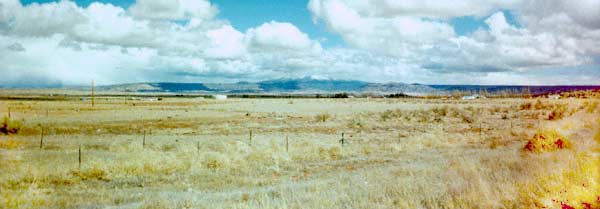

Mt. Taylor [Tsoodzi![]() ] (11301 feet)
stands north of Interstate 40 near Grants [Naatooh sik'ai'í],
New Mexico. This mountain is built up of many successive lava flows
followed by ash flows. Ash flows are made up of hot, often incandescent, fine rock
material, expelled from volcanos and lifted by internal, expanding
gases as the material avalanches down the side of the mountain.
The oldest of these flows are basalt, poor in silica and rich in iron
and magnesium, with younger
flows being of dacite and andesite. Mt Taylor [Tsoodzi
] (11301 feet)
stands north of Interstate 40 near Grants [Naatooh sik'ai'í],
New Mexico. This mountain is built up of many successive lava flows
followed by ash flows. Ash flows are made up of hot, often incandescent, fine rock
material, expelled from volcanos and lifted by internal, expanding
gases as the material avalanches down the side of the mountain.
The oldest of these flows are basalt, poor in silica and rich in iron
and magnesium, with younger
flows being of dacite and andesite. Mt Taylor [Tsoodzi![]() ] began to form almost 4 million years ago and
erupted repeatedly for two million years, building lava domes and sending
out lava flows and huge clouds of volcanic ash.
] began to form almost 4 million years ago and
erupted repeatedly for two million years, building lava domes and sending
out lava flows and huge clouds of volcanic ash.
Today the mountain is horseshoe shaped, having an interior valley as
does Mount St. Helens. This geometry suggests that, in analogy to
Mount St. Helens, Mt. Taylor [Tsoodzi![]() ] also has suffered a sideways explosion,
blowing off the top of the mountain. The large volume of debris
surrounding Mt. Taylor [Tsoodzi
] also has suffered a sideways explosion,
blowing off the top of the mountain. The large volume of debris
surrounding Mt. Taylor [Tsoodzi![]() ]
suggests that this has happened more than once, with the volcano
rebuilding itself each time. The last eruption happened over two
million years ago making the need for concern remote.
]
suggests that this has happened more than once, with the volcano
rebuilding itself each time. The last eruption happened over two
million years ago making the need for concern remote.

References
 |
